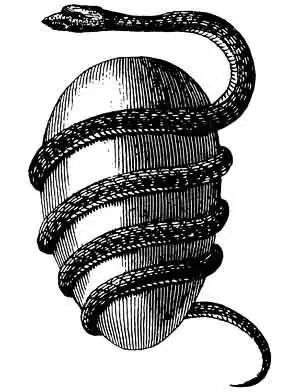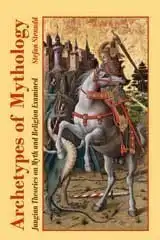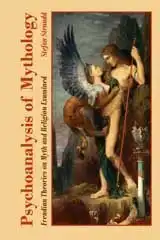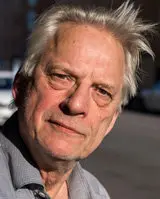Psychoanalysis of Myth 8
Applying Jung to Myth
Campbell, Eliade and others have not exactly adapted the archetypes as such, although several of those scholars admit to their existence and importance, but they have used the idea of extracting symbolic elements from the myths, and comparing these across cultural borders. Myths do have lots of similarities, no matter what culture or time they come from, and these similarities can easily be described in a manner approaching that of the archetypes. There are certain character types appearing and reappearing in countless myths — such as the hero, the sage, the god, and the child — often with recognizably similar character traits. Also, significant ingredients that are neither human nor anthropomorphic seem to pop up and look just about the same in myths without any cultural connection — such as the flood, the journey, and certainly life as well as death. Of course, this can easily be explained by the existence of these in any human life, wherever it is lived, but that is also one of the points Jung makes — the universality of those symbols. If they were not universal human experiences, they would not be archetypes. The question then is: are they symbols carrying additional meaning, or are they just heroes, sages, floods, journeys, and so forth? I have not found that Jung gives any method of proving the one or the other, nor have I seen it done by any other writer on myth. It is understandable, since this is not easily accomplished. If myths are stories of no other meaning than to entertain and excite, they would still need to contain elements of what people are acquainted to, or have vivid ideas of. Otherwise they could not make any sense at all. So, how to prove that a myth is more than just a story?
 Hercules kills the centaur Nessus, by Giambologna, 1599.
Even in the mythological tradition closest to Jung himself, that of the Old and New Testament, the hero marching triumphantly towards his self-fulfillment is much harder to find than figures of a less brilliant fate. In Genesis I, God creates the world in six days, and upon completion he does nothing more spectacular than take a rest — as if that quest was just a regular week's work. Adam does the very opposite of rising to self-realization, when spending a long life in misery after being expelled from Eden. It was actually knowledge that got him expelled — that of good and bad. Jesus has a few years of increased success, only to be painfully executed at the end, complaining that his God has forsaken him, his glorious return yet to happen. Most of the other persons in the Bible also struggle with misfortune and a God hard to please. It is not often that they end their days in any kind of bliss. Surely their stories could be interpreted differently, but not obviously so. The same is true for many a myth in the world. Hardships and tragic endings are to be found everywhere — even for heroes. If that is indeed what our collective unconscious has to teach us, then there is reason to despair. Actually, most myths are closer to tragedy than to any kind of success story. Furthermore, death is regarded with awe in most cultures and myths. Also the dead are feared in many cultures, which regard them as malcontent and malevolent. The pie in the sky when you die is offered to few others than the Christians. And the religion most connected to the idea of incarnation, Buddhism, actually preaches that this is a rotation one should do the utmost to end, by utterly and finally disappearing. Upon examination, the myths really don't say much more than that life is tough and then you die — something that our conscious is already quite aware of.
 The Buddha of Suzhou, China.
Other writers on myth have found the need to limit the application of Jung to using the idea of the archetypes as a means to sort and classify them, to some extent also in pointing out archetypal elements in the meaning extant before Jung — that of type-characters and type-events. Even when they repeatedly refer to Jung in pointing out archetypes, what they actually do is much more near just finding the recognizable components of a story — rather the opposite of symbols, since those components represent basic concepts or characters with the specific quality of being immediately recognized as such by any audience. The universality that Jung demands of myths and their components is precisely what makes any applying of his theory halt. That which is universal is immediately recognizable by all, otherwise it could not be universal, and therefore it cannot contain anything that is hidden to the conscious mind. We react to those universal elements of myths and other stories, because we recognize them and can relate to them. Otherwise they would leave us indifferent. If there are hidden clues to self-realization in myths, they are probably rare and odd and mysterious, mostly not even catching our attention — or we would be in no need of them. Yet, there is truth in the strange and complex attraction Nestor some of those archetypes Jung points out. They do ring a bell, deep in our minds. We need to ponder what in the myths makes them so fascinating to us, and what — if anything — they may tell us with those stories that we just can't let go. Most definitely, there are universal truths about the human being to be found in such an exploration. I do not think that this truth only can be found in the stories we call myths, but they are a good place to start.
NEXTConclusions: Personal myth
Psychoanalysis of Myth

MYTH
IntroductionCreation Myths: Emergence and MeaningsPsychoanalysis of Myth: Freud and JungJungian Theories on Myth and ReligionArchetypes of Mythology - the bookPsychoanalysis of Mythology - the bookIdeas and LearningCosmos of the AncientsLife Energy EncyclopediaOn my Creation Myths website:
Creation Myths Around the WorldThe Logics of MythTheories through History about Myth and FableGenesis 1: The First Creation of the BibleEnuma Elish, Babylonian CreationThe Paradox of Creation: Rig Veda 10:129Xingu CreationArchetypes in MythAbout CookiesMy Other WebsitesCREATION MYTHSMyths in general and myths of creation in particular.
TAOISMThe wisdom of Taoism and the Tao Te Ching, its ancient source.
LIFE ENERGYAn encyclopedia of life energy concepts around the world.
QI ENERGY EXERCISESQi (also spelled chi or ki) explained, with exercises to increase it.
I CHINGThe ancient Chinese system of divination and free online reading.
TAROTTarot card meanings in divination and a free online spread.
ASTROLOGYThe complete horoscope chart and how to read it.
MY AMAZON PAGE
MY YOUTUBE AIKIDO
MY YOUTUBE ART
MY FACEBOOK
MY INSTAGRAM
MY TWITTER
STENUDD PÅ SVENSKA
|
 Archetypes of Mythology
Archetypes of Mythology Psychoanalysis of Mythology
Psychoanalysis of Mythology